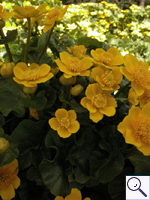|
||||||
|
CALTHA. Kingcup or Marsh Marigold [Ranunculaceae] |
|
Kingcup or Marsh Marigold (C. palustris) is the only species of Caltha recorded in Britain. It is a native species. Four British miners are recorded on Caltha. Elsewhere the agromyzid Phytomyza soenderupi is recorded feeding and pupating in the petiole, but now and then the larva may also make corridors in the leaf blade. A key to the European miners recorded on Caltha is provided in Bladmineerders van Europa. |
 Marsh-marigold Caltha palustris |
Key for the identification of the known mines of British |
|
1a > Leaf-miner: Mine linear but becoming very broad, up to 5mm, greenish, normally on lower leaves, near water (Spencer, 1972b: 91 (fig. 313), 94). After a short lower-surface beginning follows a quickly widening, upper-surface corridor that is strongly contorted, and runs from the leaf base towards the margin to widen there into a blotch. Corridor sides very irregular. Primary feeding lines well visible. Frass in pearl chains. Before pupation the larva leaves the mine through a large semicircular exit slit; however, the black puparium mostly remains stuck under the exit flap. Exit slit in lower epidermis (Pakalniskis, 2004a). |
|
|
|
Phytomyza calthivora Hendel, 1934 [Diptera: Agromyzidae]. |
|
1b > Leaf-miner: Larva forming a long, narrow, upper surface mine. Pupation external (Spencer, 1972b: 91 (fig. 313); Spencer, 1976: 394 (fig. 694), 395). Long upper-surface, parallel-sided corridor, pale green, later browned. The corridor is little contorted and hardly branching. Frass in gradually coarser grains. Pupation outside the mine; exit slit in lower epidermis (Hering, 1957) or upper epidermis (Pakalniskis, 2004a). |
|
|
|
Phytomyza calthophila Hering, 1931 [Diptera: Agromyzidae]. |
|
1c > Leaf-miner: In the first instar the larva mines the leaves, forming short, irregular, blotch-like mines, but in later instars it lives externally, feeding in spun leaves and often twisting those of tender shoots. Larval head light-brown or yellowish brown, edged with black postero-laterally, ocellar area blackish; prothoracic plate black edged with whitish anteriorly; abdomen dull dark green; pinacula distinct, black, sometimes brownish but with black bases to setae; anal plate large, black (Bradley et al., 1973). Small, full depth mine without a definite shape; little frass. Some silk is deposited in the mine. The larva soon leaves the mine and continues feeding among spun leaves. |
|
|
|
| Cnephasia incertana (Treitschke, 1835) [Lepidoptera: Tortricidae]. | |
1d > Leaf-miner: Full depth, initially a much branched corridor, irregular in width, in the end almost a blotch. The mine has openings by which part of the frass is ejected. The larvae frequently leave the mine to restart elsewhere. Older larva live free and cause window feeding, often erasing their old mines. In Coltsfoot also pseudo-mines are made, when the larva eats away the lower epidermis with the leaf tissue, but spares the dense hair cover. |
|
|
|
Phytosciara halterata Lengersdorf, 1926 [Diptera: Sciaridae]. |
|
| Last updated 01-Jul-2019 Brian Pitkin | ||
